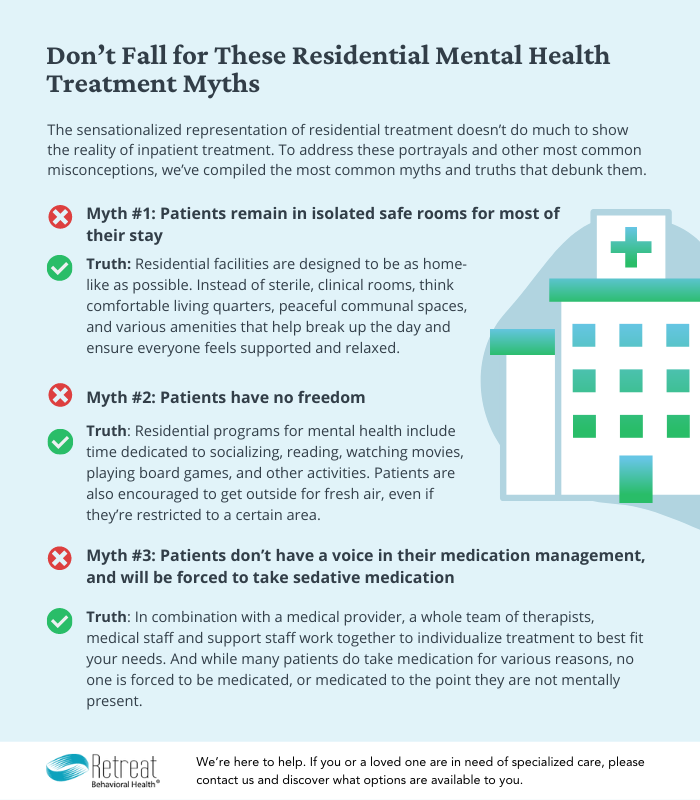Myths About Residential Treatment You Shouldn’t Fall For

Residential treatment can be incredibly helpful for individuals struggling with mental health conditions or co-occurring disorders. And yet, there are many misconceptions that make people incorrectly assume it’s a last resort—or worse, something to be afraid of.
While residential treatment isn’t always the answer, it’s important to have all of the information so that the right decision can be made. And that requires understanding the line between fact and fiction when it comes to mental health residential treatment programs.
Below, we’re exploring some of the most widely spread myths about inpatient treatment to help clear up any confusion. Here’s what to know.
Mental Health Residential Treatment Myths
The sensationalized representation of residential treatment in movies and on TV doesn’t do much to show the reality of inpatient treatment, and can actually stand in the way of people getting help.
So, what does mental health residential treatment actually look like? These are some of the differences between fact and fiction that are worth knowing about.
Myth #1: Patients remain in isolated safe rooms for most of their stay
Truth: Patients spend a considerable amount of time at residential facilities, so they are designed to be as home-like as possible. Instead of sterile, clinical rooms, think comfortable living quarters, peaceful communal spaces, and various amenities that help break up the day and ensure everyone feels supported and relaxed.
Myth #2: Patients have no freedom
Truth: Residential programs include plenty of downtime for socializing, reading, watching movies, playing board games, and other activities. Patients are also encouraged to get outside for fresh air, even if they’re restricted to a certain area.
Myth #3: Patients don’t have a voice in their medication management, and will be forced to take sedative medication
Truth: In combination with a medical provider, there is a whole team of therapists, medical staff and support staff who work together to individualize your treatment to best fit your needs. And while many patients do take medication for various reasons, no one is forced to be medicated, or medicated to the point they are not mentally present.
Acute vs. Subacute Mental Health Care
Beyond residential treatment myths, it may be useful to know about the differences between residential treatment and mental health hospitals, or subacute and acute mental health care.
Acute care is for intense and/or sudden symptoms or conditions, while sub-acute care is for individuals in need of stabilization for a chronic condition. Both are intensive, though subacute to a lesser degree; and both may fall under the larger umbrella of residential care.
Acute Mental Health Care
Patients in need of acute care generally stay in an inpatient program for a short period of time to resolve their most urgent issues. During that time, they will be provided with an ongoing treatment program that, depending on their needs, may start with a recommendation to attend a subacute residential program.
Subacute Mental Health Care
This is a transitional level of residential care and helps bridge the gap between acute care and day-to-day living. Stays may last as long as one year, during which an individual will be provided with therapy and a full treatment protocol, as well as a post-treatment plan for long-term success.
Get the Help You Need at Any Level
Don’t let misguided fears stand in the way of getting help. While myths about residential care can be unnerving, treatment programs are a lot less scary than they seem, and there’s no reason to feel shameful about needing a more intensive level of care.
If you are in need of care, we encourage you to learn about Retreat Inpatient Services and our residential programs for mental health and co-occurring disorders. Contact us today for support and get started on the path to recovery.




